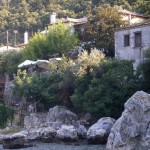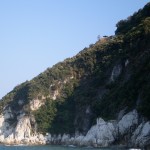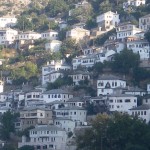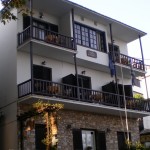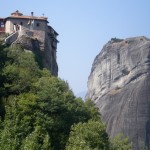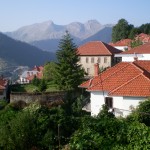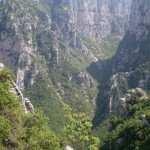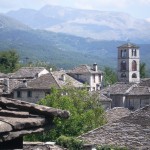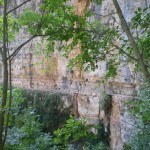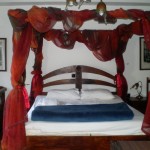The cobble-stoned path I had just descended is known as “Kagiolia”, constructed in the 19th Century in order to connect Damouhari port with Tsagarada and other villages of east Pelion. These days it is known as a lovely walk leading to isolated beaches. It is not normally used as an entrance way to Damouhari and certainly not carrying a heavy pack during the hottest hours of the day.
Wanting to be noticed by as few people as possible, I gingerly made my way along the path behind the beach. Although intent on finding a room somewhere, no matter what it cost, I found myself discounting the first couple of establishments. Then I saw the sign “Victoria Guesthouse” www.godamouhari.com and a man from the Mini Market next door spoke with me. He said, sorry, we have no room for tonight, however, from tomorrow we will have something available. I think he must have felt sorry for me as when I asked if I could leave my pack there while I went on a search elsewhere, he took me upstairs where he showed me a room that could possibly be available.
Greeks from Thessaloniki had made a booking, however, until then had not put in an appearance. He would try to telephone them. Meanwhile, he said I should rest a little in the courtyard where soon, cold water and a welcoming frappe were awaiting me. The first telephone call, no reply – second telephone call around 1830 hours, no reply. He said, if again at 1930 hours there is no reply, the room is yours. If the people arrive, we will erect a tent for you to sleep in tonight, you will not find a room anywhere. Meanwhile, please come to eat dinner with us – Victoria’s delicious Moussaka, salad and wine, followed by wonderful Crepes made by Christina, a lovely French lady staying here with her family.
Believing in what is meant to be, will be and remembering how many times, especially on this intrepid journey, everything has fallen into place for me, I was very happy although not surprised, when by 1930 hours, the Greeks had not shown and the room was mine, for as many days as I wish to stay. Although at the top of my budget range, I love this place so much, I hope to stay for a week. The business is run by a family who also own “Ghermaniko”, a traditional hotel close by. Their dedication to making all guests and customers feel at home cannot be faulted. What is more, this place and this family seem to attract the nicest of people. Christina and her family from France, an Israeli family I met this morning who have today moved on to Makrinitsa, and many others.
Last evening Christina introduced me to Rainer Winter, the Director of a documentary titled “Manolis Drosos”, adding that a screening of the film was to take place last night here in the courtyard. Filmed in 1983 in Damouhari, when it was still a fishing village and Mouresi, it is about Manolis, a local fisherman and typical figure of Damouhari in those days. The film portrays Manolis’ philosophy of life, a simple fisherman and maybe the last popular philosopher in the area. Of 90 minutes duration, it shows the beauty that is being lost and the way to maintain the authenticity that still remains. As fatigued as I was, I came downstairs for the screening – wonderful viewing, so glad to have had the opportunity.
Tuesday evening back in Makrinitsa, I noticed a Turkish lady with her young daughter, they were dining at the same Taverna as me. On Wednesday I spoke to Elchin as they waited for a bus back to Volos and she mentioned that a friend of hers had recently been in Damouhari. Last night as we waited for the screening of the film to commence, who should speak to me, none other than Elchin – it can be such a small world. Elchin and I have had several conversations now, another intrepid traveller although she does have her 5 year old daughter with her.
Here in Damouhari there is the beach and then the port. “Victoria Guesthouse” is located in the port, barely 10 metres from the sea, which in September 2007, was the setting for the harbour of the island where the “Mama Mia” movie story supposedly took place. It is where Merryl Streep received her two old friends who came for her daughter’s wedding. It was also the main setting for the song “Dancing Queen”. They built a kind of wooden marina and the big abandoned building next door to “Victoria Guesthouse” was part of the set. From all accounts, the visitors were co-operative and friendly and in particular, Merryl Streep the locals say was lovely – charming, very fit and active (do you think it could also be me who they are describing)?
Today I have not ventured anywhere, however, I will be staying on for at least a few days. A spate of heavy showers this morning were welcomed by the locals and I, having kept me grounded, however, holidaymakers with just a few days will be pleased to see blue skies and sunshine now returning. Yesterday was such a difficult day when I had need to focus my mind on arriving in a safe location and I did not bother to stop along the way for photographs. Over the next few days, I will endeavour to retrace at least part of yesterday’s road, as well as explore the area so photographs will follow.




